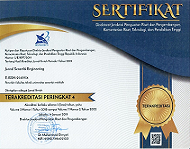Performance Analysis of Coconut Fiber Trickle Bed Filter for Municipal Wastewater Treatment
Keywords:
biofilm, biological oxygen demand, coconut fiber, domestic waste, trickling filterAbstract
The large amount of liquid waste generated from urban activities can provide negative impacts, such as disease spread, environmental damage, and others. Therefore, treatment efforts before disposal into the environmental are crucial. One method of treating liquid waste that can be used is the trickling filter. The trickling filter method used in this research utilizes natural fibers, namely coconut fiber, as the packing media, replacing sand or plastic as the packing media in conventional trickling filters. Treatment of municipal liquid waste (domestic waste) using coconut fiber trickling filters is one application of biofilm technology in wastewater treatment, where a biological layer (biofilm) like mucus will grow on the surface of the media. This biological layer will meet the wastewater and degrade the pollutant compounds present
in the wastewater, resulting in water with lower biological oxygen demand (BOD) values than before. Theresult if water that is safe for disposal into the environment. This trickling filter reactor can degrade pollutants with degradation efficiency of BOD 91.3%, nitrate 50.25%, and ammonia 37.5% at the optimal flow rate of this study (0.256 L/min).
















